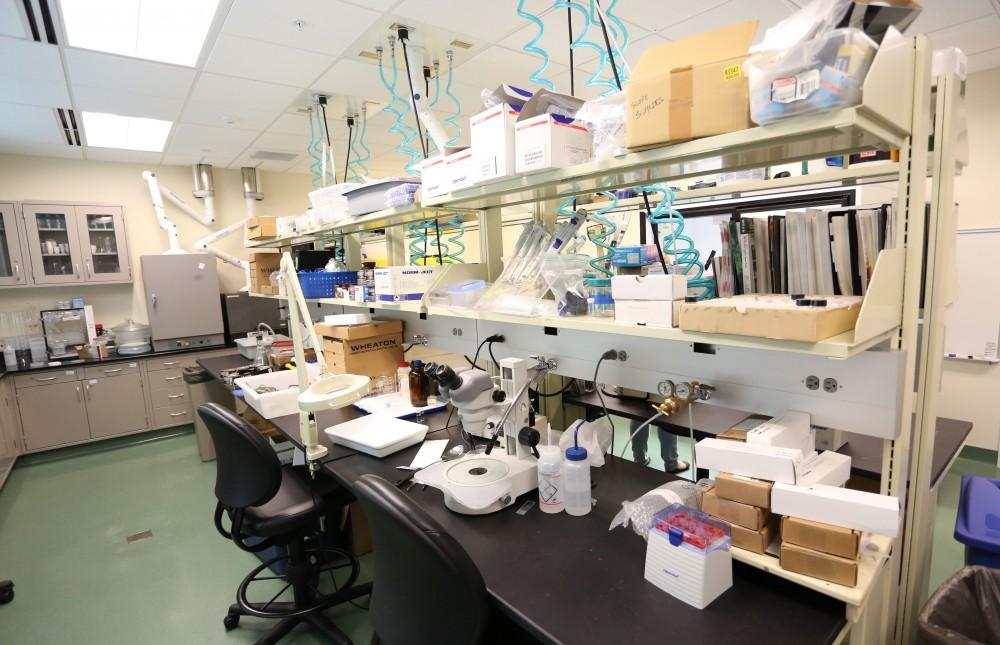Lakers get their feet wet at the AWRI

GVL / Kevin Sielaff Scenes from within Grand Valley State University’s Robert B. Annis Water Resource Institute (AWRI) operations, on Wednesday, July 8, 2015. AWRI boats programs that promote student research and engage in community outreach – all while upholding their values of freshwater preservation.
Jul 13, 2015
Summertime brings to mind one singular image for Michiganders: the Great Lakes. The mitten state is nicknamed after the surrounding lakes, and Michigan residents take great pride in being able to spend a sunny afternoon lounging about on the beaches that give the state its unique shape.
At Grand Valley State University, students and faculty are living up to their Laker name and protecting Michigan’s water.
The Annis Water Resources Institute, located in Muskegon, Mich., works to study and protect the Great Lakes, as well as other bodies of water. The institute studies everything from E.coli levels to invasive species control, as well as everything in between.
The AWRI also uses drone technology to map tree canopy cover for surrounding cities. In the past, the AWRI has done work for the National Oceanic and Atmospheric Administration, the city of Grand Rapids, and other organizations.
Along with protecting bodies of water, the AWRI offers undergraduate and graduate internships, giving students the opportunity to study under a faculty member and understand how real scientific research works.
Emily Luke, an undergraduate intern working on culturing corals from the Gulf of Mexico, said her experience at AWRI has shown her how much work goes into research.
“I’m about to be a senior, and I got involved just this summer,” Luke said. “I’m really interested in marine biology, but I knew that I was in Michigan, so anything that I could work with water would be a good start as I’m finishing school. I thought this was a really cool opportunity to get used to research and what it’s like.
“I’m enjoying it,” she said. “Working with professors, we learn how it all works and the time it takes, how much you have to put into your experiments.”
Other students at AWRI are working on projects a bit closer to home.
Microbiology undergraduate student Drew McWilliams tests lake water to ensure it is safe for the public to swim in.
“I run (the samples) through a machine, which amplifies the DNA of the E. coli so it will tell me how much E. coli I have, based off of the genes,” he said. “These samples are from Lake Michigan beaches, part of the beach monitoring.”
The samples are then reported back to the Muskegon County Health Department, where a decision is made about whether the beach needs to be closed or not.
The AWRI also hosts AquaGen, which is GVSU’s first business created within the university.
“AquaGen sequences milfoil, which is an invasive species, and tries to identify if it’s a hybrid or not, so lake associations can treat the lakes appropriately depending on what type of plant they have,” said Maggie Weinert, an AWRI technician.
The company sprouted out of research being done by GVSU graduate students, and is run by graduate student Syndell Parks. According to Weinert, milfoil is a big problem for lakes around the country.
“Herbicides are the only answer for it,” she said. “The hybrids are really hard. You might treat a whole lake, thinking that you have one type of plant and then nothing happens. So you wasted hundreds of thousands of dollars, which a lot of lake associations don’t have the chance to do it again. AquaGen tries to help beat that curve.”
Previous student work has included creating filters for countries without clean drinking water, and continuous monitoring of a buoy in Muskegon Lake.
Two major research vessels are used by the AWRI, called the W.G. Jackson and the D.J. Angus. The AWRI also has an electro-shocking boat and various other small watercrafts.
The AWRI provides multiple paid summer internships each year, as well as various opportunities during the school year. However, not many students are aware the chance for experience exists.
“A lot of times I think that main campus forgets about us, unfortunately,” Weinert said. “We’re always looking for new interns every summer, and there have been a few years where we didn’t have enough interns apply.”
Students that are interested in working with a professor at the AWRI can view the current ongoing projects at the AWRI website, and are encouraged to contact the relevant professor whose work they are interested in.
“For undergrads to get an experience of how research really works, we strive to make them see the whole process,” Weinert said. “We make our students present in front of everybody, to see how the real process is. I really like the hands-on experience. It sinks home that it’s how you do it, nobody’s just telling you how it is.
“As a graduate student, your access to boats, trucks, vehicles, gear, not a lot of other programs have that capability.”
For more information about the AWRI, including contact information for AWRI professors, visit www.gvsu.edu/wri.





















